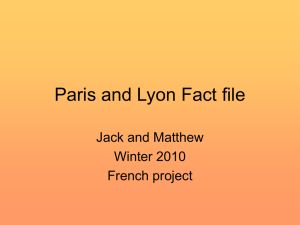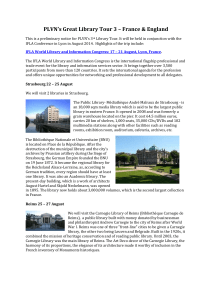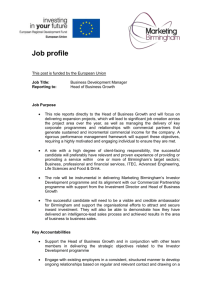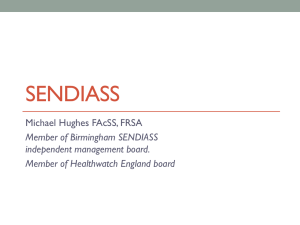About the Cities and cultural sightseeing
advertisement
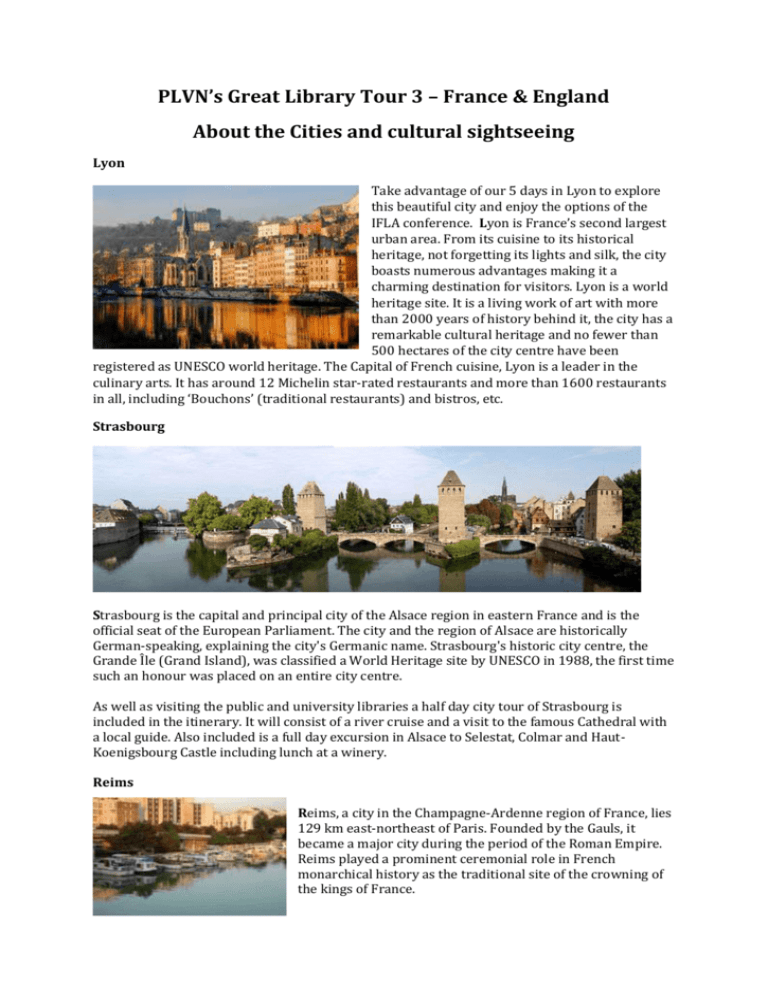
PLVN’s Great Library Tour 3 – France & England About the Cities and cultural sightseeing Lyon Take advantage of our 5 days in Lyon to explore this beautiful city and enjoy the options of the IFLA conference. Lyon is France’s second largest urban area. From its cuisine to its historical heritage, not forgetting its lights and silk, the city boasts numerous advantages making it a charming destination for visitors. Lyon is a world heritage site. It is a living work of art with more than 2000 years of history behind it, the city has a remarkable cultural heritage and no fewer than 500 hectares of the city centre have been registered as UNESCO world heritage. The Capital of French cuisine, Lyon is a leader in the culinary arts. It has around 12 Michelin star-rated restaurants and more than 1600 restaurants in all, including ‘Bouchons’ (traditional restaurants) and bistros, etc. Strasbourg Strasbourg is the capital and principal city of the Alsace region in eastern France and is the official seat of the European Parliament. The city and the region of Alsace are historically German-speaking, explaining the city's Germanic name. Strasbourg's historic city centre, the Grande Île (Grand Island), was classified a World Heritage site by UNESCO in 1988, the first time such an honour was placed on an entire city centre. As well as visiting the public and university libraries a half day city tour of Strasbourg is included in the itinerary. It will consist of a river cruise and a visit to the famous Cathedral with a local guide. Also included is a full day excursion in Alsace to Selestat, Colmar and HautKoenigsbourg Castle including lunch at a winery. Reims Reims, a city in the Champagne-Ardenne region of France, lies 129 km east-northeast of Paris. Founded by the Gauls, it became a major city during the period of the Roman Empire. Reims played a prominent ceremonial role in French monarchical history as the traditional site of the crowning of the kings of France. An evening city tour of Reims includes a visit to the Cathedral. The Cathedral of Reims (damaged by the Germans during the First World War but restored since) played the same role in France as Westminster Abbey has in the United Kingdom. Paris Paris is situated on the River Seine, in the northern central part of the country, at the heart of the Île-de-France region. It covers an area of about 87 square kilometres and is surrounded by an orbital motorway. Within its administrative limits (the 20 arrondissements), Paris is one of the largest population centres in Europe, with more than 12 million inhabitants. We will be staying in the 11th arrondissement of Paris. The eleventh arrondissement is a varied and engaging area. To the west lies the Place de la République which is linked to the Place de la Bastille, in the east, by the sweeping, tree-lined Boulevard Richard-Lenoir, with its large markets and children's parks. The Place de la Bastille and the rue du Faubourg St Antoine are full of fashionable cafés, restaurants, and nightlife, and they also contain a range of boutiques and galleries. The Rue Oberkampf|Oberkampf district to the north is another popular area for nightlife. The east is more residential, with more wholesale commerce, while the areas around the Boulevard Voltaire and the Antoine-Augustin Parmentier|Avenue Parmentier are livelier crossroads for the local community. In recent years this district has emerged as one of the trendiest regions of Paris. Included in the itinerary is a half day city tour of Paris and a free day to explore this beautiful city. London 31 August – 3 September London is the capital city of England and the United Kingdom. With an estimated 8,308,369 residents in 2012, London is the most populous region, urban zone and metropolitan area in the United Kingdom. Standing on the River Thames, London has been a major settlement for two millennia, its history going back to its founding by the Romans. London is a leading global city, with strengths in the arts, commerce, education, entertainment, fashion, finance, healthcare, media, professional services, research and development, tourism and transport all contributing to its prominence. It is one of the world's leading financial centres and has the fifth- or sixth-largest metropolitan area GDP in the world depending on measurement. London has been described as a world cultural capital. It is the world's mostvisited city as measured by international arrivals and has the world's largest city airport system measured by passenger traffic. London contains four World Heritage Sites: the Tower of London; Kew Gardens; the site comprising the Palace of Westminster, Westminster Abbey, and St Margaret's Church; and the historic settlement of Greenwich. Other famous landmarks include Buckingham Palace, the London Eye, Piccadilly Circus, St Paul's Cathedral, Tower Bridge, Trafalgar Square, and The Shard. London is home to numerous museums, galleries, libraries, sporting events and other cultural institutions, including the British Museum, National Gallery, Tate Modern, British Library and 40 West End theatres. The London Underground is the oldest underground railway network in the world. Included in the itinerary is a half day tour of the city. Oxford Oxford is the county town of Oxfordshire, and forms a district within the county. The city is known worldwide as a university town and home of the University of Oxford, the oldest university in the country and the English-speaking world. Buildings in Oxford demonstrate an example of every English architectural period since the arrival of the Saxons, including the iconic, mid-18th-century Radcliffe Camera. Oxford is known as the "city of dreaming spires", a term coined by poet Matthew Arnold in reference to the harmonious architecture of Oxford's university buildings. Included in the itinerary is a visit to Warwick Castle, a medieval castle developed from an original built by William the Conqueror in 1068. Warwick is the county town of Warwickshire, situated on a bend of the River Avon. The original wooden motte-and-bailey castle was rebuilt in stone in the 12th century. During the Hundred Years War, the facade opposite the town was refortified, resulting in one of the most recognisable examples of 14th century military architecture. It was used as a stronghold until the early 17th century, when it was converted it to a country house. It was owned by the Greville family, who became earls of Warwick in 1759, until 1978 when it was bought by the Tussauds Group. Birmingham 5 September Birmingham is a city and metropolitan borough in the West Midlands of England. It is the most populous British city outside the capital London with 1,074,300 residents. A medium-sized market town during the medieval period, Birmingham grew to international prominence in the 18th century at the heart of the Midlands Enlightenment and subsequent Industrial Revolution, which saw the town at the forefront of worldwide developments in science, technology and economic organisation, producing a series of innovations that laid many of the foundations of modern industrial society. Today Birmingham is a major international commercial centre, ranked as a beta− world city by the Globalization and World Cities Research Network; and an important transport, retail, events and conference hub. Its major cultural institutions, including the City of Birmingham Symphony Orchestra, the Birmingham Royal Ballet and the Barber Institute of Fine Arts, enjoy international reputations. The Big City Plan is a large redevelopment plan currently underway in the city centre with the aim of making Birmingham one of the top 20 most liveable cities in the world within 20 years.
